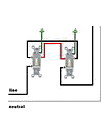» Home Electrical Wiring
» Electrical Wiring Directory
» Wiring Diagrams
» Need Electrical Help? Ask the Electrician
» Wiring Diagrams
» Need Electrical Help? Ask the Electrician
Godown Wiring Diagrams
|
|
Summary:
Fully Explained Godown Wiring Diagrams with the layout, circuit and switch wiring and the explanation of the switch positions and lighting results. © By: Dave Rongey |
Godown Wiring for Warehouse Lighting Applications
The godown wiring method is popular for warehouses where there is one entrance and the lighting should be on only in the occupied area.
Although this is a method of switch wiring that works quite well it does have one drawback because the lighting will work for only one occupant in one area.
If an additional person enters the warehouse and turns on the switch near them then it will turn off the light where the first person is located.
| The traditional godown wiring method is explained here starting with the layout of a warehouse application. For simplicity, the warehouse has three lights and three switches with equal spacing in between. This design could be adjusted and adapted to any size warehouse and adjustments to the size of the circuit will need to be adjusted for the total load, or watts of the actual lighting that will be used and the size of the wire will need to be adjusted for voltage drop in a large warehouse or building. |
Godown Wiring Layout |
|
 |
|
Godown Wiring Connections |
|
 |
|
Godown Observation Table |
|||||
| S1 | S2 | S3 | L1 | L2 | L3 |
| OFF | OFF | OFF | DARK | DARK | DARK |
| ON | OFF | OFF | BRIGHT | DARK | DARK |
| ON | ON | OFF | DARK | BRIGHT | DARK |
| ON | ON | ON | DARK | DARK | BRIGHT |
Godown Wiring Legend |
||
| NOTE: ALL DIMENSIONS ARE IN CMS. |
L | LAMP |
| S | SWITCH | |
| F | FUSE | |
| NL | NEUTRAL LINE | |
| SPST | SINGLE POLE SINGLE THROW | |
| SPDT | SINGLE POLE DOUBLE THROW | |
| CONNECTION TERMINAL | ||
| It should be noted that this design specifies 230 volt 50hz, however this wiring method could also be used for 120 volt, 60 hz, or any other voltage as long as the wiring, light fixtures and switches are rated for the same voltage and application factors. |
More about Godown Wiring
Learn more about Godown Wiring |
The Safest Way to Test Electrical Devices and Identify Electric Wires!The Non-Contact Electrical TesterThis is a testing tool that I have had in my personal electrical tool pouch for years, and is the first test tool I grab to help identify electrical wiring. It is a Non-contact tester that I use to easily Detect Voltage in Cables, Cords, Circuit Breakers, Lighting Fixtures, Switches, Outlets and Wires. Simply insert the end of the tester into an outlet, lamp socket, or hold the end of the tester against the wire you wish to test. Very handy and easy to use.
The Quickest Way to Check for Faulty Electrical Wiring!The Plug-In Outlet TesterThis is the first tool I grab to troubleshoot a problem with outlet circuit wiring. This popular tester is also used by most inspectors to test for power and check the polarity of circuit wiring. It detects probable improper wiring conditions in standard 110-125 VAC outlets Provides 6 probable wiring conditions that are quick and easy to read for ultimate efficiency Lights indicate if wiring is correct and indicator light chart is included Tests standard 3-wire outlets UL Listed Light indicates if wiring is incorrect Very handy and easy to use.
Strip Off Wire Insulation without Nicking and Damaging the Electric Wire!The Wire Stripper and Wire CutterMy absolute favorite wire stripping tool that I have had in my personal electrical tool pouch for years, and this is the tool I use to safely strip electrical wires. This handy tool has multiple uses: The wire gauges are shown on the side of the tool so you know which slot to use for stripping insulation. The end of the tool can be used to grip and bend wire which is handy for attaching wire onto the screw terminals of switches and outlets.. The wire stripper will work on both solid and stranded wire. This tool is Very Handy and Easy to Use. |
||
Residential Electrical Parts and AccessoriesLight Switches 120volt Outlets Circuit Breakers Electrician Tools Voltage Testers |















